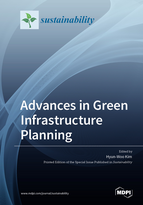Advances in Green Infrastructure Planning
A special issue of Sustainability (ISSN 2071-1050).
Deadline for manuscript submissions: closed (30 November 2021) | Viewed by 16599
Special Issue Editor
Special Issue Information
Dear Colleagues,
The expansion of urban areas has facilitated the conversion of undeveloped lands, which has led to environmental degradation, such as loss of habitats, hydro-modification, and the collapse of existing ecosystems. Recent climate change has exacerbated these damages by causing more frequent and serious hazards. To attenuate the impacts of urbanization and the negative effects of climate change, green infrastructure (GI) planning (e.g., nature-based strategies, technologies, policies, and solutions) has arisen as an important approach for balancing urban development and nature. GI offers a variety of benefits to our cities by reducing stormwater runoff, heat waves, and air pollution; expanding wildlife habitats; and increasing recreational opportunities and even nearby property values.
While many studies have revealed various positive effects of GI, further contributions to the linkage of hubs and corridors; the adoption of up-to-date, smart, low-impact developments practices; urban environmental and hazard management planning; and indirect physical or social effects are still encouraged to promote more systematic and sustainable decision-making processes for different types of green spaces.
In this context, we invite submissions in this Special Issue across a broad spectrum of GI applications at multiple scales, ranging from planning aspects to on-site approaches. In particular, studies contributing to the empirical assessment of GI in addressing urban climate adaptation and hazard management are encouraged. Topics of interest include the following:
- Landscape patterns and configurations;
- Green space connectivity;
- Urban flooding and stormwater management;
- Urban heat mitigation;
- Air quality reduction;
- Low-impact development practices;
- Park and green space planning;
- Planning and policy assessments and reviews;
- Smart green infrastructure.
As these topics are brief examples, other novel or emerging themes relating GI planning to hazard mitigation and climate change adaptations are welcome.
Prof. Dr. Hyun-Woo Kim
Guest Editor
Manuscript Submission Information
Manuscripts should be submitted online at www.mdpi.com by registering and logging in to this website. Once you are registered, click here to go to the submission form. Manuscripts can be submitted until the deadline. All submissions that pass pre-check are peer-reviewed. Accepted papers will be published continuously in the journal (as soon as accepted) and will be listed together on the special issue website. Research articles, review articles as well as short communications are invited. For planned papers, a title and short abstract (about 100 words) can be sent to the Editorial Office for announcement on this website.
Submitted manuscripts should not have been published previously, nor be under consideration for publication elsewhere (except conference proceedings papers). All manuscripts are thoroughly refereed through a single-blind peer-review process. A guide for authors and other relevant information for submission of manuscripts is available on the Instructions for Authors page. Sustainability is an international peer-reviewed open access semimonthly journal published by MDPI.
Please visit the Instructions for Authors page before submitting a manuscript. The Article Processing Charge (APC) for publication in this open access journal is 2400 CHF (Swiss Francs). Submitted papers should be well formatted and use good English. Authors may use MDPI's English editing service prior to publication or during author revisions.
Keywords
- green infrastructure
- landscape connectivity
- urban flooding
- urban heat island effect
- fine dust
- LID
- plan evaluation
- smart technologies






